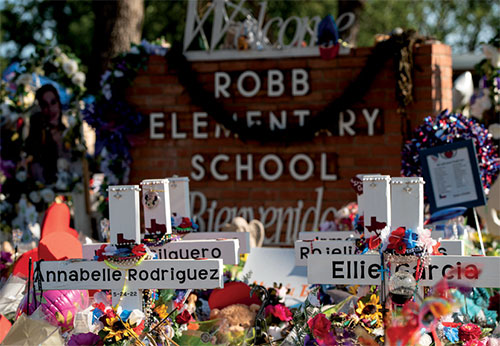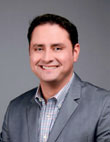The Pulteney StreetSurvey
The memorial at Robb Elementary School in Uvalde, Texas following the 2022 mass shooting, whose victims where cared for by Dr. Gilberto Arbelaez ’06, Sc.D. ’23.
PHOTO BY JINITZAIL HERNANDEZ/SHUTTERSTOCK
How the Scene Unfolded in Uvalde
As the only emergency physician on staff at Uvalde Memorial Hospital after the tragic shooting at Robb Elementary School, Dr. Gilberto Arbelaez ’06, Sc.D. ’23 led the emergency care team in treating victims.
This story was originally published on July 2, 2022 by ACEPNow. Reprinted here with permission of American College of Emergency Physicians.
When Gilberto Arbelaez, MD, arrived for his shift at Uvalde Memorial Hospital on May 24, he hit the ground running as usual. Though Uvalde, Texas only has 15,000 residents, Memorial has an emergency department that stays busy. That morning, Dr. Arbelaez had already managed a flash pulmonary edema patient who required intubation and diagnosed a thoracic aortic dissection. He was on the phone with specialists in San Antonio, trying to transfer these patients out for further care, when he heard the security guard’s nearby radio: “Gun shots fired.”
Then, hospital staffers started getting phone calls and texts as word spread through the small town: The shooting is at the elementary school. Someone who was shot in the face is being flown out to San Antonio. This is real.
THE RESPONSE
Dr. Arbelaez and his team kicked into preparation mode. The hospital floors were being refinished that morning, so the emergency department had been temporarily relocated to a different, smaller area of the hospital. The flooring crew was dismissed, and everyone worked urgently to return the emergency department to its optimal setup. Some of the staffers worked to quickly discharge non-emergent patients, as the rest of the team gathered extra beds, intubation trays, chest tubes, and tourniquets.
And then, they waited. “It seemed like it took forever,” Dr. Arbelaez said. He felt a sinking dread as the minutes of trauma’s golden hour ticked away, the emergency department still empty. Never before had he wished for more patients in his emergency department. Finally, they got the call from EMS that their first patient was en route.
“Everybody was gowned and gloved. Lines were primed, everything was ready,” Dr. Arbelaez said. “We were waiting for the ambulance to arrive in the emergency entrance when all of the sudden, we heard shouting from the lobby. For some reason the ambulances decided to bring the patients through the main doors.”
They turned in unison and looked down the hallway to see two young girls being pushed toward them on gurneys. Dr. Arbelaez and the general surgeon received the first child who was in dire condition. “[The surgeon] did a cut to try a pericardial window, and there was no bleeding from her skin whatsoever,” Dr. Arbelaez said. “She was completely exsanguinated by the time she got to us.”
Next came a child shot in the shoulder and buttocks. Then a teacher with gunshot wounds in the arm, chest, and back. Then another young girl who had been shot in her chest, arm, and hand. A boy arrived, already covered in a white sheet. He was taken to the only space available for the deceased— the hospital chapel.
Dr. Arbelaez evaluated a young girl who had taken a ricocheting bullet to the face. It entered her right nostril and lodged in the upper left portion of her nose. She wasn’t bleeding, wasn’t even crying, and had only minimal associated fractures. For Dr. Arbelaez, viewing her scan was one of the few moments of relief during a day of horror. He shook his head and thought back to viewing her scan: “Millimeters in another direction and it could have killed her.”
Dr. Arbelaez, the only emergency physician on staff that day, and his small emergency care team of one physician assistant and a few nurses were joined by family physicians and a pediatrician, who took the lower acuity patients, and a radiologist with a portable X-ray machine who helped read scans as quickly as possible. Off-shift staff who heard the news dropped everything to come help at the hospital.
The Southwest Texas Regional Advisory Council (STRAC), designated by the Texas Department of State Health Services (DSHS) to develop, implement, and maintain the regional trauma and emergency health care system for more than 26,000 square miles in southwest Texas, helped Uvalde Memorial coordinate transfers of patients to associated hospitals in San Antonio, including University Hospital, San Antonio Military Medical Center, and Methodist Children’s Hospital.
As they worked, the members of the medical team—some of whom had children and grandchildren at the school—were hearing bits and pieces of information: The shooting has ceased. No, shots are still being fired. Kids are calling for help on cell phones. They’re pulling them out of windows. Kids are running away barefoot because they were making paper maché shoes … The uncertainty was excruciating. Dr. Arbelaez could see his colleagues had tears in their eyes, but they stayed focused. “They never lost their cool,” he said. “They never complained. Everyone just kept going.”
Dr. Arbelaez has a five-year old daughter, and he kept imagining himself in the same situation as the Robb Elementary parents. He clicked into an “emotionless” state to cope with the horror of the situation and to continue providing his best care to the victims. “I’m not sure if that’s the best way to put it, but I felt if I put any kind of emotion into it, I’d just be frozen and not be able to do what I’m supposed to do.”
As the pace began to slow and the health care professionals finally were able to take a deep breath, the emotions came in waves. It wasn’t until 6 p.m. when Dr. Arbelaez was dictating the charts for the 20 victims they received, that the gravity of what he had witnessed began to sink in. “I was like, my God, look at all these bullet wounds and lacerations and mangled arms and mangled hands,” he recalled. He kept flashing back to that moment in the hallway when they turned around to see the first child being rushed through the lobby by EMS, but she was already gone.
At the end of their shift, the medical team gathered outside the ambulance bay to talk about what they had just been through together. They spent 10 minutes talking through the scene, the preparation, and their response. Team members shared how they were feeling and expressed gratitude for every member of the team. They hugged and cried and had a moment of silence for the victims. Taking a moment to pause and reflect “was helpful for everyone,” Dr. Arbelaez said.
THE AFTERMATH
In the days that followed, Dr. Arbelaez worked his string of day shifts as planned. He felt staying busy was his best option. “Very few people outside of work understand what we go through,” he explained. He said it was therapeutic to be around his colleagues who were there that day. While they lean on one another as needed, Dr. Arbelaez and his coworkers are also receiving counseling to help them process and cope.
In addition to helping coordinate hospital transfers during the initial crisis, STRAC sent mental health professionals to help staff and local first responders process their trauma. The organization deployed extra health care workers to Uvalde in the weeks after the tragedy to relieve the usual emergency department (ED) team members who needed to rest and recharge.
Uvalde is a close-knit community where “everyone has only two degrees of separation,” Dr. Arbelaez said. And if everyone is connected, everyone is sharing this pain. He thinks it’s too soon to know how much this trauma will impact those involved, but he knows the anguish is acute and widespread.
“We’ve seen multiple parents coming in with anxiety,” he said. “It sort of relives everything again, right? Because then you put a face to the parents who were searching for their kiddo. They’re anxious and distraught and there’s nothing, nothing I can say or do to help ease their pain and grief.”
For his part, Dr. Arbelaez sometimes wakes up in the middle of the night, his mind racing through different aspects of the tragedy.
He thinks about the stoic looks on the kids’ faces as he took care of them that day. “These kids did not cry at all—the kids who got shot,” he said. “They came in scared, but I didn’t see a single tear in those kids, not a single one.”
He thinks about how his training prepared him for this day. Dr. Arbelaez is grateful that he had mass casualty training during his emergency medicine residency at the University of Connecticut. “I had a moment after all of this where I thought, ‘Imagine if I had not trained at a Level I trauma center?’ I’m just glad I had the tools and the staff to be able to save a couple lives that otherwise wouldn’t have been saved.”
He thinks about the way the Uvalde Memorial ED staff responded to the shooting. “[That hospital] has one of the most efficient and cohesive teams I’ve ever worked with,” he said. His team was ready and waiting, but what if they didn’t have to wait so long? Could they have saved more lives?
He thinks about school shootings. He was in high school when Columbine happened. He was an emergency medicine resident in Connecticut when 26 people were killed at Sandy Hook Elementary. And now this. “It feels like no kiddo is safe,” he said.
And Dr. Arbelaez thinks about his own child. Her safety, her future. He remembers how the first two victims reminded him so much of her.
“We [emergency physicians] like to fix things … it’s just kind of the way we’ve been trained and sort of our personalities,” he said. “I just don’t know why we can’t fix this problem. We’re the most advanced country in the world, and we can’t get out of this hole.”

Dr. Gilberto Arbelaez ’06 is an emergency medicine specialist with expertise in diagnosing and treating patients with life-threatening conditions from heart failure to drug overdose to traumatic injury. A first-generation college student, he was a pre-med biology major at HWS and went on to earn his M.D. from the University of Connecticut School of Medicine, where he completed his residency and received masscasualty training. In 2023, Hobart and William Smith awarded him an honorary doctorate for his exceptional bravery and steadfast, lifesaving work as a physician.
©2023, American College of Emergency Physicians, Reprinted with Permission.
